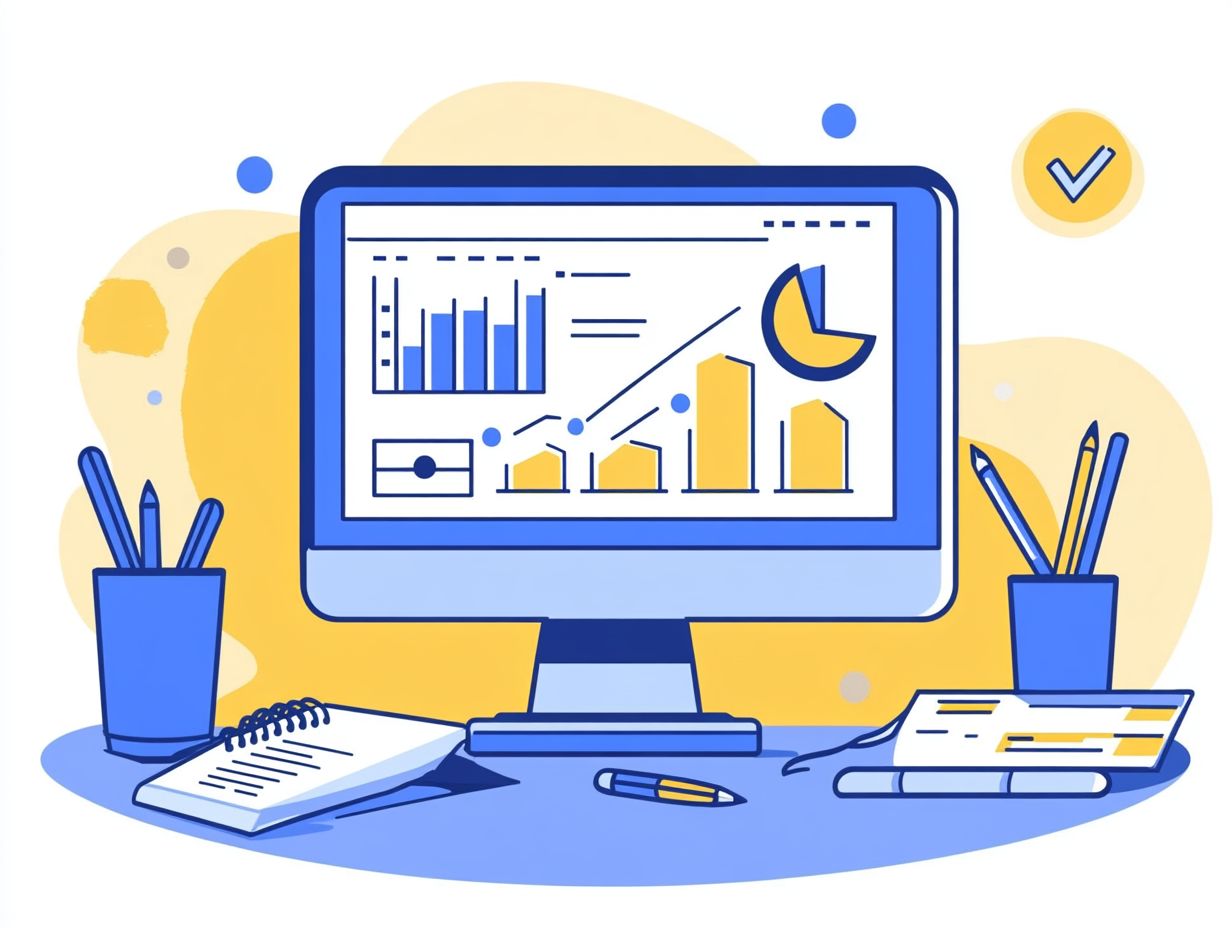In today’s digital landscape, grasping the fundamentals of SEO is essential for any website owner aiming to enhance their online visibility.
This guide breaks down the essentials of search engine optimization (SEO), offering beginners a clear pathway through key elements like on-page SEO techniques and effective keyword research.
Discover how factors such as meta tags, website structure, and loading speed can influence your search rankings, and why building quality backlinks is critical.
Dive into tools like Google Analytics and Google Search Console to gain valuable insights and explore best practices for optimizing your site for mobile users and improving mobile optimization.
Eager to master the art of SEO? Let’s get started!
What is SEO and why is it important for your website?
SEO, or search engine optimization, improves your website’s visibility on search engines like Google to increase organic traffic. In today’s digital market, effective SEO and website optimization are necessary for better search rankings, attracting more visitors, and driving conversions.
By optimizing elements like content quality and site architecture, your site can meet search algorithm requirements and user needs.
This involves both on-page SEO techniques, such as using relevant keywords and optimizing meta tags and title tags, and off-page SEO strategies like building authority through quality backlinks and social signals.
Balancing these approaches helps improve search rankings and establish a reliable online presence.
Analytics are crucial, helping businesses monitor performance, understand user behavior, and adjust strategies. Investing in strong SEO practices boosts visibility and significantly contributes to business growth, making it essential for success in the digital world.
What are the key components of on-page SEO?
On-page SEO involves strategies applied directly to your website to improve its search visibility and user engagement. This includes optimizing meta tags, title tags, header tags, and ensuring high-quality content that matches the audience’s search intent.
Effective on-page SEO also requires proper keyword placement and using alt text for images, which can improve user experience and enhance your site’s relevance for search engines.
Meta tags give search engines information about the webpage and should have appealing descriptions to attract clicks. Title tags should be concise and descriptive, ideally with primary keywords near the start.
Header tags organize content hierarchically, helping users navigate the page and showing search engines the most important topics. Beyond technical elements, high-quality content is crucial; keywords should fit naturally to make articles informative and engaging without overloading them.
These components work together to create a smooth user experience, which influences the page’s ranking in search results.
How to conduct keyword research for beginners?
Keyword research is an essential part of SEO that helps you understand what your audience is searching for online. Beginners can use tools like the keyword planner to find relevant keywords and long-tail keywords that bring targeted traffic to your website.
Analyzing competitors can show which keywords they rank for, revealing opportunities for your own content strategy.
By understanding search intent, you can categorize keywords as informational, navigational, or transactional, matching them with your audience’s needs. This alignment makes your content more relevant and engaging to readers.
Using keyword analysis tools allows you to continuously refine your strategy. Focus on metrics like search volume and competition level to prioritize keywords effectively.
Regularly reviewing and adjusting your approach based on performance data and competitor insights will improve your rankings and enhance your overall content marketing efforts.
What are meta tags and how do they impact SEO?
Meta tags are pieces of code that describe your page’s content to search engines and users, crucial for SEO and visibility in search results. Two key types are title tags and meta descriptions, which appear in search results and affect click-through rates.
By optimizing these with relevant keywords and clear information, you can improve your website’s performance on search engine results pages (SERPs) and attract more organic traffic.
These tags help search engines index content and engage users browsing search results. A well-crafted title tag, ideally 50 to 60 characters long and with strategic keywords, helps visitors quickly see the page’s relevance. For example, a title like ’10 Tips for Effective Time Management – Boost Productivity’ aligns with search intent and invites clicks.
Similarly, meta descriptions, about 160 characters long, provide a brief summary that can attract users. An engaging meta description could be ‘Discover proven strategies to optimize your time and enhance productivity in our comprehensive guide.’
By using these meta tags effectively, you can significantly boost user engagement and, eventually, search ranking.
How to optimize your website’s content for search engines?
Optimizing your website’s content for search engines requires a strategic approach to meet user needs and search criteria. This involves improving content quality by offering valuable information, using relevant keywords, and placing them appropriately throughout your articles.
SEO tools can help analyze your content’s effectiveness, guide improvements according to best practices, and conduct thorough competitor analysis.
To boost visibility and increase conversions, conduct thorough keyword research to find terms that appeal to your target audience. Fresh content is important for maintaining relevance, as search engines prefer updated material addressing current trends and user queries.
Understanding user intent is crucial for creating content that attracts clicks and meets readers’ needs. Tools like Google Analytics and SEMrush can provide insights into performance metrics, helping identify which keywords drive engagement and conversions.
By continuously refining strategies based on analysis and performance metrics, content can better serve both users and search engines.
What role does website structure play in SEO?
Website structure is crucial for SEO, as it affects how search engines crawl and index your site. A well-organized site architecture improves crawlability, helping search engines navigate your pages and understand your content’s relevance.
By using a clear, logical structure with internal links and a user-friendly design, you can enhance your website’s indexability and user experience.
A well-defined website architecture aids search engine processes and directly impacts user engagement and bounce rate. A clear hierarchy with well-labeled categories and subcategories makes it easy for visitors to find information quickly, reducing bounce rates and encouraging longer visits.
To further optimize your site, use breadcrumbs for easy navigation and ensure important pages are just a few clicks from the homepage. Descriptive URLs and a mobile-responsive design are also essential for boosting visibility and usability, leading to better SEO performance.
How to improve your website’s loading speed for better SEO?
Improving your website’s loading speed is crucial for a better user experience and higher SEO rankings. A fast site lowers bounce rates and boosts user engagement, which search engines consider when assessing your site’s quality.
Techniques like optimizing images, using browser caching, and making your site mobile-friendly can greatly improve speed and performance.
- Minifying CSS and JavaScript files can make your code more efficient, leading to faster loading pages.
- Additionally, using a content delivery network (CDN) distributes content across servers worldwide, speeding up access for users everywhere.
Faster sites not only offer a better user experience, encouraging more conversions, but they also tend to rank higher in search results. By focusing on these technical SEO elements, website owners can strengthen their online presence and increase conversion rates.
What are backlinks and how do they influence your site’s ranking?
Backlinks are links from other websites that point to your pages, and they significantly affect your site’s ranking in search engines. High-quality backlinks from reputable sites improve your domain and page authority, indicating to search engines that your content is trustworthy and relevant.
Using effective link-building strategies helps you gain valuable backlinks and external linking that enhance your SEO performance.
In digital marketing, backlinks are crucial. They not only improve rankings but also support organic search strategies by driving referral traffic and increasing visibility.
Websites with strong social media engagement often see increased organic traffic and improved online reputation, as shares and likes can create more link opportunities.
To build backlinks successfully, focus on creating high-quality, shareable content and actively connect with other creators in your field to build relationships and collaborate. Additionally, using influencer marketing can significantly contribute to your link-building efforts.
How to use Google Analytics and Search Console for SEO insights?
Google Analytics and Google Search Console are useful tools that offer insights into your website’s performance, SEO success, and help track user behavior. Google Analytics tracks user behavior, traffic patterns, and conversion rates, while Search Console monitors your site’s health, indexing status, and search visibility.
Analyzing data from these tools can help you spot areas for improvement and adjust your SEO strategies.
Understanding metrics from Google Analytics can aid in a thorough technical audit of your site and help refine your content strategy based on user behavior and traffic sources. By looking at metrics like bounce rates and session duration, you can identify where visitors might lose interest.
Google Search Console provides insights on search queries and click-through rates, helping you identify keywords that drive organic traffic, so you can optimize content more effectively using on-page SEO techniques and keyword research.
Using insights from both SEO tools promotes a user-focused approach, leading to improved search engine rankings and better user engagement overall.
What are the best practices for mobile optimization in SEO and search engine optimization?
Mobile optimization is essential today, especially with search engines prioritizing mobile-first indexing. Ensure your responsive design adapts to various screen sizes, enhance site speed for mobile users, and optimize content for quick loading times to reduce bounce rate.
Focusing on mobile optimization can increase user engagement, improve search rankings, and enhance overall user experience.
Creating a seamless user experience involves understanding mobile users’ search intent and behaviors. Prioritize fast loading times, as users often leave sites that take longer than a few seconds to load, impacting your site’s conversion rate and engagement metrics.
Use technical SEO tactics, such as image optimization, minimizing CSS and JavaScript, and ensuring proper URL structure, to further improve performance. A well-optimized mobile site meets search engine requirements and provides an intuitive experience, encouraging users to stay and explore longer, thus boosting your site’s page authority.
How to stay updated on SEO trends and algorithm updates?
Keeping up with SEO trends and algorithm changes is crucial for maintaining your website’s search visibility and performance metrics. Regularly following well-regarded SEO blogs, industry experts, and Google updates helps you adjust your strategies to the changes in digital marketing and search engine optimization.
Listening to user feedback provides insights into how changes affect your audience and helps you fine-tune your content strategy and website design approach.
Consider joining online forums and discussion groups where professionals share their experiences and insights to further enhance your knowledge. Using analytics tools like Google Analytics allows for a deeper competitive analysis, showing which strategies are driving traffic and conversions for others in your industry. This can also highlight effective link building and local SEO practices.
By consistently observing these trends and adapting your content marketing efforts, including using A/B testing and content freshness tactics, you can keep your website relevant and anticipate market shifts. Subscribing to newsletters from top SEO authorities ensures you stay updated, enabling you to make informed decisions to keep your site competitive and improve your domain authority.




